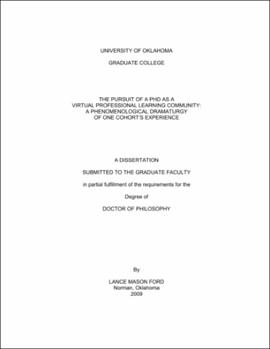| dc.contributor.advisor | O'Hair, Mary J||Vaughn, Courtney A | |
| dc.creator | Ford, Lance | |
| dc.date.accessioned | 2019-04-27T21:39:14Z | |
| dc.date.available | 2019-04-27T21:39:14Z | |
| dc.date.issued | 2009 | |
| dc.identifier | 9956043902042 | |
| dc.identifier.uri | https://hdl.handle.net/11244/319280 | |
| dc.description.abstract | Education can be a lonely business. Teachers and administrators | |
| dc.description.abstract | are often separated from other adult professionals in isolated | |
| dc.description.abstract | classrooms, offices, and administration buildings. Geographic | |
| dc.description.abstract | remoteness only exacerbates personal seclusion, preventing | |
| dc.description.abstract | collaboration concerning how to foster student learning and wellbeing. | |
| dc.description.abstract | Bringing a disparate group of potentially isolated educational leaders | |
| dc.description.abstract | together, in 2005 the Educational Administration Department (EAD) at | |
| dc.description.abstract | Central University in the United States created a local/distance (mixed) | |
| dc.description.abstract | PhD cohort. Pathways, a special unit embedded within EAD, | |
| dc.description.abstract | spearheaded the plan; infused the curriculum with collaborative | |
| dc.description.abstract | community literature; intended to enhance student administrative | |
| dc.description.abstract | expertise; and, if desired, prepared students for the college professorate. | |
| dc.description.abstract | I was a cohort member, and my co-author taught four research courses | |
| dc.description.abstract | scattered throughout the program. Classes are over now, and 13 out of | |
| dc.description.abstract | 14 original members are defending prospecti and dissertations. | |
| dc.description.abstract | For the most part Pathways realized its expectations, and the | |
| dc.description.abstract | group became a professional learning community (PLC). This study | |
| dc.description.abstract | produced three thematic lenses through which to see the cohort's | |
| dc.description.abstract | evolution: job-related challenges, technology struggles, and interpersonal | |
| dc.description.abstract | relationships. This methodology centers on a phenomenological | |
| dc.description.abstract | dramaturgy. Cooley (1922) and Mead (1934/1967) guided our view of the | |
| dc.description.abstract | phenomenon as the cohort's historical group development toward each | |
| dc.description.abstract | individual's evolving professional- and self-perceptions within a | |
| dc.description.abstract | community context. We present the findings in a four-act play | |
| dc.description.abstract | (Goffman,1959). Our special attention to students speaks to future virtual | |
| dc.description.abstract | and local doctoral cohort developers and those who theorize about | |
| dc.description.abstract | successful doctoral education. Being a good educator means paying | |
| dc.description.abstract | attention to details--in this case, the ever-changing social selfconstructions | |
| dc.description.abstract | that can make or break a student's experience. | |
| dc.format.extent | 205 pages | |
| dc.format.medium | application.pdf | |
| dc.language | en_US | |
| dc.relation.requires | Adobe Acrobat Reader | |
| dc.subject | Distance education--Drama | |
| dc.subject | Universities and colleges--Graduate work--Drama | |
| dc.subject | Doctoral students--Drama | |
| dc.subject | Didactic drama | |
| dc.title | THE PURSUIT OF A PHD AS A VIRTUAL PROFESSIONAL LEARNING COMMUNITY: A PHENOMENOLOGICAL DRAMATURGY OF ONE COHORT'S EXPERIENCE | |
| dc.type | text | |
| dc.type | document | |
| dc.thesis.degree | Ph.D. | |
| ou.group | Jeannine Rainbolt College of Education::Department of Educational Leadership and Policy Studies | |
